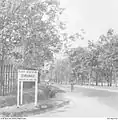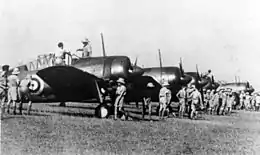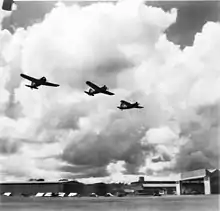Sembawang Air Base | |||||||||||||||
|---|---|---|---|---|---|---|---|---|---|---|---|---|---|---|---|
 Badge of the Sembawang Air Base | |||||||||||||||
| Summary | |||||||||||||||
| Airport type | Military airbase | ||||||||||||||
| Owner | Government of Singapore | ||||||||||||||
| Operator | Republic of Singapore Air Force | ||||||||||||||
| Location | Sembawang, Singapore | ||||||||||||||
| Elevation AMSL | 26 m / 86 ft | ||||||||||||||
| Coordinates | 01°25′31″N 103°48′46″E / 1.42528°N 103.81278°E | ||||||||||||||
| Runways | |||||||||||||||
| |||||||||||||||
The Sembawang Air Base (ICAO: WSAG) is a military airbase of the Republic of Singapore Air Force (RSAF) located at Sembawang, in the northern part of Singapore. The base motto is Swift and Resolute.
History
RAF Sembawang
Before Singapore's independence from the United Kingdom, it was a Royal Air Force station known as RAF Sembawang as well as being the Royal Naval Air Station – HMS Simbang – to the carrier pilots of the Royal Navy Fleet Air Arm (attached to the Eastern Fleet based in Singapore) who used it for rest and refit whenever an aircraft carrier of the Royal Navy berthed at the nearby HMNB Singapore for refuel and repairs, which also housed the largest Royal Navy dockyard east of Suez up to the time of UK forces withdrawal from Singapore.
After the Japanese capture of Singapore during World War II, the Imperial Japanese Navy Air Service took over the two RAF stations of Sembawang and Seletar. Singapore was split into north–south spheres of control, and the Imperial Japanese Army Air Force took over RAF Tengah. It was not until September 1945 that the two airfields reverted to British control following the Japanese surrender.
RAF Sembawang was a key part of Britain's continued military presence in the Far East (along with the three other RAF bases in Singapore: RAF Changi, RAF Seletar, RAF Tengah) during the critical period of the Malayan Emergency (1948–1960), the Brunei Revolt in 1962 and the Indonesia–Malaysia confrontation (1962–1966).
Units
1941–42
- No. 62 Squadron RAF (detachment) – Bristol Blenheim I.[1]
- No. 21 Squadron, Royal Australian Air Force (RAAF) – Brewster Buffalo
- No. 453 Squadron RAAF – Brewster Buffalo I.[2]
1945–1971
Royal Air Force
- No. 28 Squadron RAF – Supermarine Spitfire FR.18.[3]
- No. 60 Squadron RAF – Spitfire F.18.[1]
- No. 194 Squadron RAF reformed here during February 1953 from the Far East Casevac Flight – Westland Dragonfly HC.2.[4]
- No. 656 Squadron RAF reformed here on 29 June 1948 from No. 1914 Flight RAF – Auster AOP.5.[5]
Royal Navy
- Aircraft Holding Unit Sembawang.[6]
- Naval Aircraft Support Unit Sembawang.[7]
- 791 Naval Air Squadron[8]
- 800 Naval Air Squadron[9]
- 802 Naval Air Squadron[10]
- 804 Naval Air Squadron[11]
- 806 Naval Air Squadron[12]
- 807 Naval Air Squadron[13]
- 811 Naval Air Squadron[14]
- 812 Naval Air Squadron[15]
- 814 Naval Air Squadron[16]
- 815 Naval Air Squadron[17]
- 816 Naval Air Squadron[18]
- 817 Naval Air Squadron[19]
- 820 Naval Air Squadron[20]
- 824 Naval Air Squadron[21]
- 825 Naval Air Squadron[22]
- 826 Naval Air Squadron[23]
- 827 Naval Air Squadron[24]
- 837 Naval Air Squadron[25]
- 845 Naval Air Squadron[26]
- 846 Naval Air Squadron[27]
- 847 Naval Air Squadron[28]
- 848 Naval Air Squadron[29]
- 849A Naval Air Squadron[30]
- 888 Naval Air Squadron[31]
- 1700 Naval Air Squadron[32]
- 3 Commando Brigade Air Squadron
Sembawang Air Base
The base was renamed Sembawang Air Base (SBAB) in 1971 when it was handed over to the Singapore Air Defence Command (SADC). From 1971 to 1976, under the auspices of the Five Power Defence Arrangements (FPDA), Sembawang housed British, Australian and New Zealand forces.
In 1983, the airbase became a full-fledged rotary-wing air base when the first resident helicopter squadron – 120 Squadron – was permanently relocated from Changi Air Base.
In the late 1990s, the extension of Sembawang Airbase has acquired the portion of Lorong Gambas and Lorong Lada Merah for redevelopment works.
Organisation
Currently, there are approximately 100 helicopters based in Sembawang Air Base, almost all are operating in support of the Singapore Army and the Republic of Singapore Navy. It is the home base to all the RSAF helicopter squadrons, consisting of Eurocopter AS332 Super Pumas, Boeing CH-47SD Chinooks, Sikorsky S-70B (derivative of Sikorsky SH-60 Seahawk) naval helicopters,[33] as well as the Eurocopter Fennecs and Bell UH-1Hs, which are currently stored in reserve. Recently added to the base are the Boeing AH-64D Longbow Apache attack helicopters.
The Flying squadrons are:
- 120 Squadron with 20 AH-64D Longbow Apaches;
- 123 Squadron with 6 S-70B Seahawks, these are owned and operated by the Republic of Singapore navy but flown by RSAF pilots;
- 124 Squadron with 5 EC120 Colibri, headquartered at SBAB with a training detachment at Seletar Airport;
- 125 Squadron with 22 AS332M Super Puma & Airbus H225, four of these are configured for Search and rescue duties;
- 126 Squadron with 12 AS532UL/AL Cougar;
- 127 Squadron with 6 CH-47D and 12 CH-47SD Chinooks.[34]
The Support Squadrons are:
- Aircraft Operations Engineering Squadron – 806 SQN
- Aircraft Specialist Engineering Squadron – 816 SQN
- Airbase Sustainment Squadron – 706 SQN
- Airbase Civil Engineering Squadron – 506 SQN
- Force Protection Squadron – 606 SQN
- Control Squadron – 206 SQN
Currently, the RSAF's Chong Pang Camp with its associated Air Defence assets, is also located within the compound of the air base as well as the famous local Sembawang Hot Spring.
Photo gallery
 Entrance of RAF Sembawang, c. 1941.
Entrance of RAF Sembawang, c. 1941. Brewster Buffalo Mark Is being inspected by RAF personnel, April 1941.
Brewster Buffalo Mark Is being inspected by RAF personnel, April 1941. Brewster Buffalo fighters of No. 453 Squadron RAAF, November 1941.
Brewster Buffalo fighters of No. 453 Squadron RAAF, November 1941. Brewster Buffalo aircraft of No. 21 Squadron flying over RAF Sembawang.
Brewster Buffalo aircraft of No. 21 Squadron flying over RAF Sembawang. The staff and personnel from Sembawang Air Base Air Logistic Squadron posing in front of the helicopters currently in RSAF service.
The staff and personnel from Sembawang Air Base Air Logistic Squadron posing in front of the helicopters currently in RSAF service. 120 Squadron AH-64D Longbow Apache on static display during RSAF Open house.
120 Squadron AH-64D Longbow Apache on static display during RSAF Open house. 125 Squadron Super Puma takes off from the flight deck of the RSS Resolution – an Endurance-class LST. Visible in the foreground is the Aircraft Ship Integrated Secure and Traverse (ASIST) system.
125 Squadron Super Puma takes off from the flight deck of the RSS Resolution – an Endurance-class LST. Visible in the foreground is the Aircraft Ship Integrated Secure and Traverse (ASIST) system._h.jpg.webp)
See also
References
Citations
- 1 2 Jefford 1988, p. 44.
- ↑ Jefford 1988, p. 93.
- ↑ Jefford 1988, p. 34.
- ↑ Jefford 1988, p. 67.
- ↑ Jefford 1988, p. 103.
- ↑ Howard 2011, p. 11.
- ↑ Howard 2011, p. 143.
- ↑ Sturtivant & Ballance 1994, p. 115.
- ↑ Sturtivant & Ballance 1994, p. 126.
- ↑ Sturtivant & Ballance 1994, p. 135.
- ↑ Sturtivant & Ballance 1994, p. 142.
- ↑ Sturtivant & Ballance 1994, p. 150.
- ↑ Sturtivant & Ballance 1994, p. 153.
- ↑ Sturtivant & Ballance 1994, p. 166.
- ↑ Sturtivant & Ballance 1994, p. 169.
- ↑ Sturtivant & Ballance 1994, p. 176.
- ↑ Sturtivant & Ballance 1994, p. 183.
- ↑ Sturtivant & Ballance 1994, p. 187.
- ↑ Sturtivant & Ballance 1994, p. 189.
- ↑ Sturtivant & Ballance 1994, p. 201.
- ↑ Sturtivant & Ballance 1994, p. 215.
- ↑ Sturtivant & Ballance 1994, p. 220.
- ↑ Sturtivant & Ballance 1994, p. 224.
- ↑ Sturtivant & Ballance 1994, p. 230.
- ↑ Sturtivant & Ballance 1994, p. 252.
- ↑ Sturtivant & Ballance 1994, p. 260.
- ↑ Sturtivant & Ballance 1994, p. 268.
- ↑ Sturtivant & Ballance 1994, p. 273.
- ↑ Sturtivant & Ballance 1994, p. 276.
- ↑ Sturtivant & Ballance 1994, p. 280.
- ↑ Sturtivant & Ballance 1994, p. 314.
- ↑ Sturtivant & Ballance 1994, p. 336.
- ↑ http://www.defencetalk.com/singapore-begins-operating-new-s-70-helicopters-24948/ 'Defence Talk : Singapore Begins Operating New S-70 Helicopters'
- ↑ Gunner, Jerry (November 2011). "Chinook at 50 – World Wokka Operators – Republic of Singapore Air Force". Air Forces Monthly. Vol. 284. Key Publishing Ltd. p. 88. ISSN 0955-7091.
Bibliography
- Howard, L; Burrow, M; Myall, E (2011). Fleet Air Arm helicopters since 1943. UK: Air-Britain (Historians) Ltd. ISBN 978-0-85130-304-8.
- Jefford, C G (1988). RAF Squadrons. A comprehensive record of the movement and equipment of all RAF squadrons and their antecedents since 1912. Shrewsbury: Airlife. ISBN 1-85310-053-6.
- Sturtivant, R; Ballance, T (1994). The Squadrons of The Fleet Air Arm. Tonbridge, Kent, UK: Air-Britain (Historians) Ltd. ISBN 0-85130-223-8.
External links
- History of RAF
- RSAF web page on Sembawang Air Base (SBAB)
- Background history of R.N.A.S. Sembawang
- Naval Historical Society of Australia
- Royal Navy Research Archive